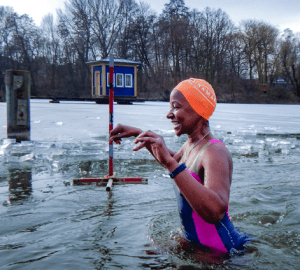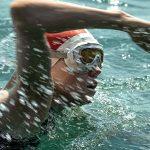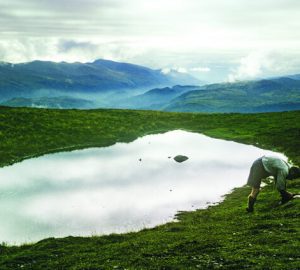What can we learn about swimming from kids – and what can we do to keep kids swimming?
This weekend my daughter took part in our local swimming club championships. It was pool swimming obviously, not open water, but I think we (as adult open water swimmers) can learn a thing or two from these youngsters and we should also consider what type of example and message we should give them.
When I watch the kids swimming it’s usually with a mixture of admiration and envy. I struggle to understand how a 12 year old, with four years’ swimming experience, can swim faster than me, with more than 40 years of practice. But some do, and many of those that can’t already will probably do so soon. So, I decided to watch a bit more closely to see what could be learnt. Some perhaps is obvious, and some perhaps less so.
Technique
Good technique is naturally and predictably a pre-requisite for fast swimming, especially over longer distances. However, despite most of these youngsters being in the same club and coming through the same teaching and coaching system, there was a relative lack of uniformity in the details. For example, the swimmers displayed a range of breathing patterns and styles on front crawl from single sided to standard (every three) bilateral breathing to less regular patterns such as two-left, two right or two right, one left. There was variety in head position, with some looking straight down and others more to the front and different arm shapes during the recovery part of the stroke.
Lesson: work on improving technique but remember we’re not all the same and that fitness also matters
Starts and turns
The best swimmers had these nailed. From the dive, they’d hit the water cleanly, travel a good distance under water and come out in front. I saw some swimmers win races on the strength of their starts and turns – making up more distance off the wall each time than they lost to swimmers who moved through the water faster.
Lesson: it’s worth practising starts and turns even if you will only race in open water as they help your general fitness and conditioning, and if you ever do race in a pool, it would be very satisfying to beat faster swimmers by virtue of your turns.
Courage
It’s always impressive to watch people taking on tough events like the 400m individual medley or the 200m fly. It’s more so when they are 10 years old, have never done those distances before and have no idea if they will actually make it – and those events are on the same day. I don’t think this was driven pushy parents. The kids have seen Michael Phelps win Olympic medals in these events and want to give it a go. And sometimes it ended in tears. Other times, the determination is incredible as they struggle through the last 50m of butterfly while barely able to clear their arms from the water but the smiles on the faces afterwards showed that they thought the pain was worth it.
Lesson: take on a challenge slightly bigger than you think you can manage, and see what happens.
Pacing
The results of poor pacing are painful to watch. A child dives in, races off, arms spinning and just can’t sustain the pace. The arms slow, the breathing becomes desperate and all sense of rhythm is lost. The more experienced swimmers look like they’re hardly trying during the first part of a long race yet their splits are remarkably consistent and they easily catch up and pass those who took off too fast.
Lesson: practise pacing
But how do we keep kids swimming?
One thing that does strike me about swimming is the massive drop off in numbers as you move up through the age groups. Swimming has a very high attrition rate and I think the extremely competitive structure of the sport is partly to blame. In the younger age groups you’ll see a massive range of abilities from the plucky losers to future world champions. By the time you get to the older age groups the ability range is narrower and the numbers are much smaller.
If you show ‘talent’ as a 10 year old (perhaps because you are an earlier-developer and are considerably stronger than your peers) you’ve got a chance of being moved into a special training squad with a better coach to swimmer ratio, you’ll be offered more swimming time and encouraged to enter galas to represent your club. You’ll become part of an elite and your swimming performances will improve accordingly.
If, instead, you’re not so quick, you’ll be left to fester in the crowded slower lanes and you won’t get to swim for the club and enjoy the thrill and motivation of swimming for a team. Your opportunities for additional swimming classes will be limited and you’ll become disillusioned as younger ‘talented’ kids race past you. There’s a good chance you will abandon swimming within the next couple of years.
Coaches’ careers are often built on pushing swimmers to national and international competition and a club’s reputation can be hugely enhanced by sending a swimmer to the Olympics so it’s not surprising that these pathways and pressures exist. Pool time for clubs is precious, so you can understand (but not necessarily agree with) the logic of reserving as much of it as possible for your potential future champions. But sometimes you get the impression that club swimming is only about developing elite swimmers and overlooks the vital job of encouraging swimming for life, for all.
One of the great things about open water swimming, and some of the new open water swimming clubs that are springing up, is that competition is a relatively minor concern. Of course, part of the role of the club is to help swimmers improve – but that improvement is a personal journey for your own satisfaction rather than the win or lose pursuit of glory. Additionally, the fun and social side of swimming is given much great prominence. This is how to keep people swimming for life rather than quitting the sport, disillusioned. It would be good to see more opportunities for teenagers to keep swimming for fun and general fitness as well as for those who want to devote their lives to it. Open water swimming should be part of that solution.






